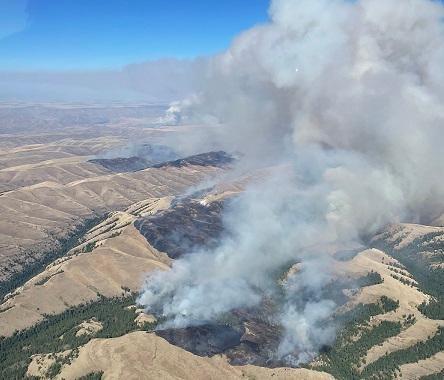
Lincoln County Montana is a beautiful place. Heavily forested, with the Cabinet Mountains as a backdrop, the vistas are what draw people here.
Scattered through this forested landscape are small rural towns that have grown accustomed to smoke-filled summer skies. Wildfire has become a part of life here. And wildfire doesn’t care about boundaries.
Over the past 10 years, the number of large fires impacting these communities has steadily increased. In 2015, the Klatawa Fire threatened homes and the municipal watershed for the town of Libby. The Gibraltar Ridge Fire in 2017 near Eureka burned nearly 13,000 acres and threatened homes. That same year, the Caribou Fire burned over 25,000 acres, destroying 10 homes and numerous outbuildings. The West Fork Fire exceeded 20,000 acres, again threatening homes and infrastructure in Libby. Two years later, in 2019, the Gold Hill Fire burned 6,700 acres and again threatened homes. In 2021, the South Yaak and Burnt Peak Fires burned more than 16,000 acres near Troy, threatening homes and private lands.

Lincoln County ranks in the top 10% for wildfire risk to communities, according to WildfireRisk.org. Nearly 99% of lands in the county are forested; the Kootenai National Forest manages most of them.
Because of heavily forested conditions and extreme fire activity, the Kootenai Complex on the Kootenai National Forest was designated as one of the initial 10 Wildfire Crisis Strategy Landscapes in 2022. This designation emphasizes the need to accelerate hazardous fuels and wildfire risk reduction for the local communities of Trego, Eureka, Libby, Troy, Stryker and Fortine. The landscape also includes a portion of Bonner County, Idaho near Moyie Springs and Bonner’s Ferry.
Harmony Burow, a fuels management specialist on the Rexford and Fortine Ranger Districts on the Kootenai National Forest, understands the urgency. She has been working with local partners including the Montana Department of Natural Resources, The Nature Conservancy and local fire districts to address hazardous fuels across ownership boundaries. She understands the challenge that must be confronted collaboratively.

“Funding associated with the ‘Wildfire Crisis Strategy’ landscape has allowed us to accelerate fuels reduction projects in key areas,” said Burow. “We have primarily been awarding contracts to local businesses and they have done outstanding work for us.”
Contracts increase the Forest Service’s capacity for treating more acres each year. More importantly, they support local businesses in small rural communities. Treating hazardous fuels not only reduces the wildfire risk to communities, but also puts food on local families’ tables.
One such contractor is All In Excavation, owned and operated by Cory Burk. Burk grew up in Lincoln County and worked for another local contractor before starting his own business two years ago. He says the work he does for the Forest Service positively impacts his company.
“There is more work out there to do than contractors willing to do it,” said Burk. “That made growing my company faster than I anticipated a very real thing.”

When he started the business, Burk planned to work alone for a few years and then entertain the idea of expanding. With the work available through the “Wildfire Crisis Strategy” and Kootenai Complex Landscape, he hired three employees within the first year. The emphasis of his business switched from dirt moving to brushing, slashing and piling to reduce hazardous fuels.
Burk gets lots of positive feedback from the public, too.
“People drive by and give me a thumbs-up,” said Burk.
When people stop to ask about what he is doing, Burk likes to tell them about how this work is important and necessary.
“We are doing all good things - helping the forest and the community,” he added.





